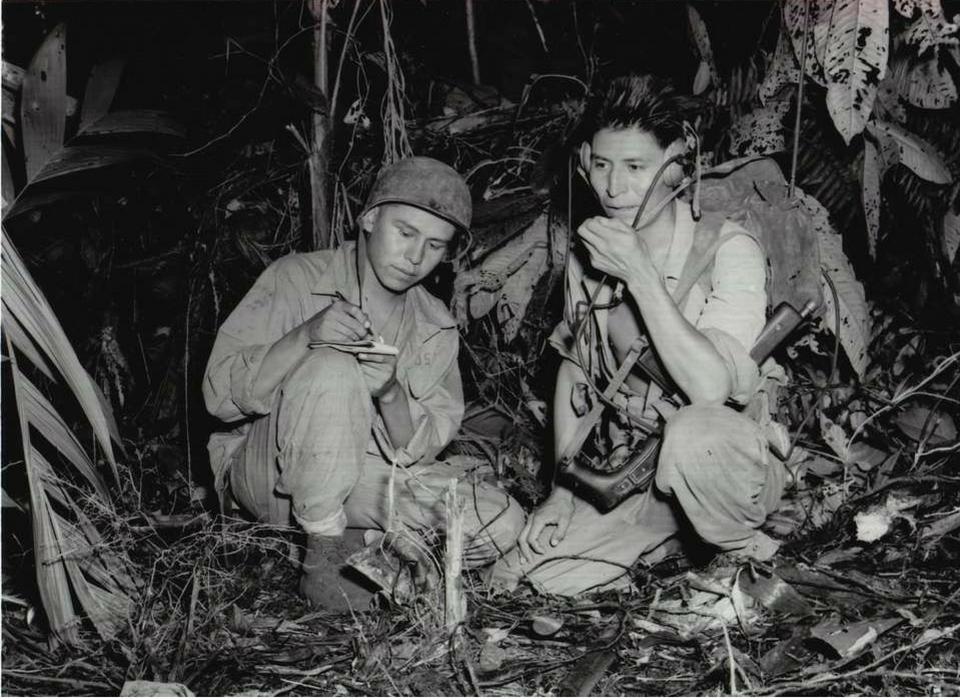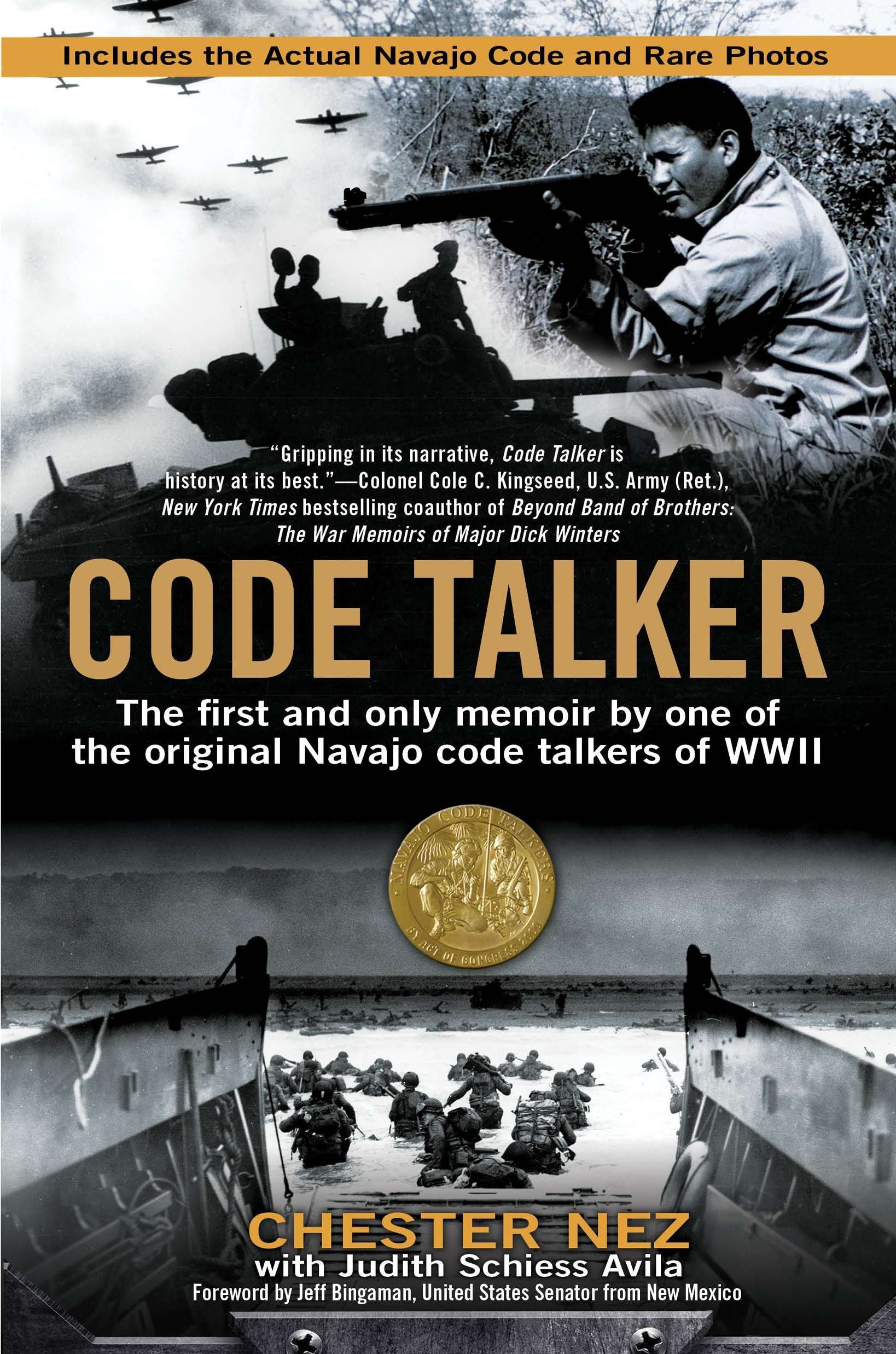“Of course, even after we compiled a comprehensive list of military terms, there was still a problem. In Navajo, no equivalent for words like ‘fighter plane’ existed. We chose animals and other items from our everyday world that resembled the military equipment. So ‘fighter plane’ was represented by the quick and maneuverable hummingbird, code word da-he-tih-hi. The huge transport planes were represented as an eagle who carried prey, atsah. A battleship was a whale, code word lo-tso, and a destroyer was a shark, code word ca-lo. A cruiser was a small whale, code word lo-tso-yazzie. In choosing each code word, we talked about how the animal chosen lived and hunted, and we did our best to link it up logically with a piece of military equipment. Sometimes we used non-animal items to represent certain things. A hand grenade was a potato, or nimasi. Bombs were eggs, or a-ye-shi. Japan was slant-eye or beh-na-ali-tsosie.
“There was no Navajo equivalent for months of the year, since we did not divide our calendar into twelve chunks. Instead, we used concepts to describe each month. January, a cold month, was ‘crusted snow’ or yas-nil-tes. The month of April, when spring sprouts begin to grow, was ‘small plant’ or tah-chill. June, when much planting is done, became ‘big planting’ or be-ne-eh-eh-jah-tso.
“In addition to the alphabet, we devised nearly 220 terms for various concepts and diverse types of military equipment. A code name, Ne-he-mah, was chosen to represent the United States of America. Ne-he-mah translates to ‘our mother.’
“Living the Right Way, we men knew that things must be in harmony. We didn’t compete with each other. We continued to help any of our buddies who needed help. As traditional Navajos, we had a bond of understanding. In our new roles as Marines, we continued to work together.”
Chester Nez, Code Talker, p. 109-110.
Code Talker is the only memoir from one of the 420 young Navajo men who served as communication specialists in World War II. Since their language was not written down, it was virtually undecipherable to the Japanese. On the battlefield, the code talkers could respond almost immediately to developments, directing attention to enemy actions, and providing direction for their fellow Marines to respond via infantry, artillery, and other means.
There are several elements to the above passage that make it memorable. The first is the foreign nature of military technology and war. The code talkers had to create and adopt terms in the Navajo language to make the code practical and effective for their fellow Marines, whose lives would often be in the balance and dependent upon the clarity of battlefield communications. The Navajo language was developed conceptually around the natural world and the elements found within it. It is fascinating to see how the young code talkers created the code, adopting the characteristics of military equipment and technology to animals and their characteristics as hunters in nature. The idea of a transport plane being an eagle carrying prey is unforgettable to me, once I read and understood what the code talkers were seeking to communicate, in simple and fast terms. Similarly, until I read this account, I did not know that the Navajo did not divide the year into 12 months. Again, it is fascinating to see how the Navajo corresponded time to the natural seasons. “Crusted snow” as January, or “small plants” symbolizing the springtime month of April, make sense to an outsider to the Navajo culture, once it’s explained in one’s native language and cultural terms.
Another element that makes a deep impression upon the reader is the sense of patriotism and loyalty that Nez and his fellow Navajo felt to their country and their fellow Marines. Designating the United States as Ne-he-mah, our mother, showed the depth of commitment that these men had for a country whose history with the Native American peoples had not always been harmonious or just. One of the attractions and motivations to military service for Chester Nez was the opportunity to see and experience the outside world beyond the Navajo reservation he had spent his life on in New Mexico and Arizona. But what I think really transformed Nez and the other 29 men in the first class of Navajo code talkers, beyond seeing the city and lights of San Diego, the Pacific Ocean for the first time, and life on the transport ships and faraway lands where the war was fought, were the bonds the men developed among themselves as Navajo code talkers and their roles as guardians of their fellow Marines on the battlefield.
One last note should be made of the above passage that makes it unforgettable: In a sentence that jars our modern sensibilities, Nez describes how the Navajo used a racial feature and term to describe the Japanese enemy. It is a reminder of the realities of war. While the term might offend sensibilities today, it is also clear that such language was perhaps the least offensive reality that men and women were dealing with in war. Nez himself would find that the realities of war gave no quarter to his own cultural sensibilities, and that in order to survive he would have to perform acts that he would never face in his peacetime life and culture. These issues will be the subject matter of my next post.
Note: This is the first of two posts on Chester Nez's memoir. Read Part Two.

“A place can evoke the history that occurred there, but through words our minds truly gain perspectives and understanding of what it was like to know, feel, experience, hope, fail, triumph, and live through events from which we ourselves were absent. The written word is our most intricate map to retrace and reconstruct what we think happened, and ultimately brings us back to ourselves.”
– Keith Huxen, PhD , Senior Director of Research and History, The National WWII Museum
Keith Huxen
Keith is the former Senior Director of Research and History in the Institute for the Study of War and Democracy at The National WWII Museum.
Cite this article:
MLA Citation:
APA Citation:
Chicago Style Citation:








![Max Fuchs, New York City cantor, sings as Rabbi Sydney [sic] Lefkowitz, Richmond, VA, conducts the first Jewish services from Germany.](/sites/default/files/styles/max_650x650/public/2025-10/image1.jpg)

